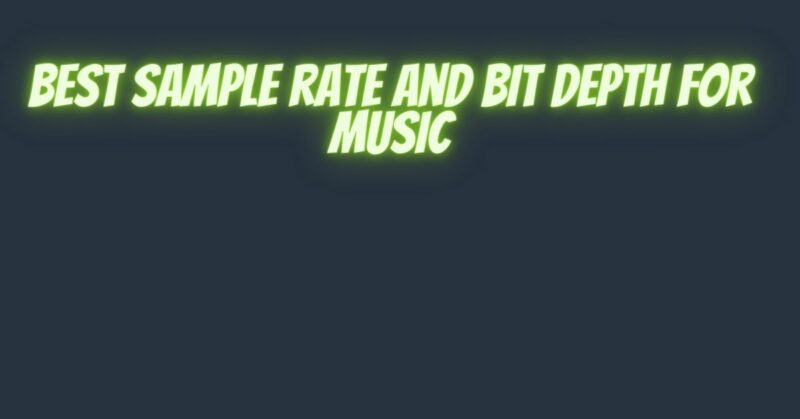In the world of digital music production, selecting the appropriate sample rate and bit depth is a crucial decision that can significantly impact the quality and flexibility of your audio recordings. This article aims to guide musicians, producers, and engineers in choosing the best sample rate and bit depth for their music projects, considering various factors that influence this decision.
Understanding Sample Rate and Bit Depth
- Sample Rate: Sample rate, measured in Hertz (Hz), determines how many audio samples are captured per second. Common sample rates in music production include 44.1 kHz, 48 kHz, 96 kHz, and 192 kHz. A higher sample rate allows for more accurate representation of audio, particularly at higher frequencies.
- Bit Depth: Bit depth refers to the number of bits used to quantize each audio sample. Common bit depths include 16-bit and 24-bit. A higher bit depth provides greater dynamic range, allowing for more precise representation of audio amplitude.
Factors Influencing Sample Rate and Bit Depth Choice
Several factors should be considered when determining the best sample rate and bit depth for your music project:
- Musical Genre: The genre of music you’re producing can influence the sample rate and bit depth choice. Genres that emphasize acoustic subtleties and intricate details, such as classical or jazz, may benefit from higher sample rates and bit depths. In contrast, genres like electronic or rock music may not require the same level of detail.
- Recording Quality: The quality of your recording equipment, including microphones and preamps, plays a significant role. High-quality recordings often justify the use of higher sample rates and bit depths to capture nuances accurately.
- Distribution Format: Consider the final distribution format of your music. If your tracks will primarily be released digitally, formats like CD (44.1 kHz, 16-bit) or high-resolution audio (96 kHz, 24-bit) may be appropriate. If your music will be streamed on platforms like Spotify, they may automatically convert to specific formats.
- Processing and Editing: Higher bit depths (e.g., 24-bit) are advantageous during the recording and editing phases. They offer more headroom and flexibility, allowing for greater manipulation without introducing audible artifacts.
Sample Rate and Bit Depth Recommendations
Here are some common sample rate and bit depth combinations and their typical applications:
- 44.1 kHz, 16-bit: This is the standard for CD audio. It’s a practical choice for most music production, particularly if your primary distribution format is CD or digital streaming platforms.
- 48 kHz, 24-bit: A versatile option suitable for a wide range of musical genres and recording scenarios. It’s commonly used in video production as well.
- 96 kHz, 24-bit: Preferred for high-fidelity recordings, especially when capturing intricate acoustic details. It’s often used in classical, jazz, and audiophile music production.
- 192 kHz, 24-bit: Reserved for specialized applications and extreme audio fidelity requirements. The benefits of 192 kHz may not be noticeable in many musical genres.
Selecting the best sample rate and bit depth for your music production is a critical decision that should align with your musical goals, equipment quality, and distribution format. While higher sample rates and bit depths offer greater precision and flexibility, they come with increased file sizes and processing demands. In many cases, a sample rate of 44.1 kHz or 48 kHz with a bit depth of 24-bit provides an excellent balance between audio quality and practicality for most music projects. Ultimately, the choice should be based on the specific needs and objectives of your music production.


